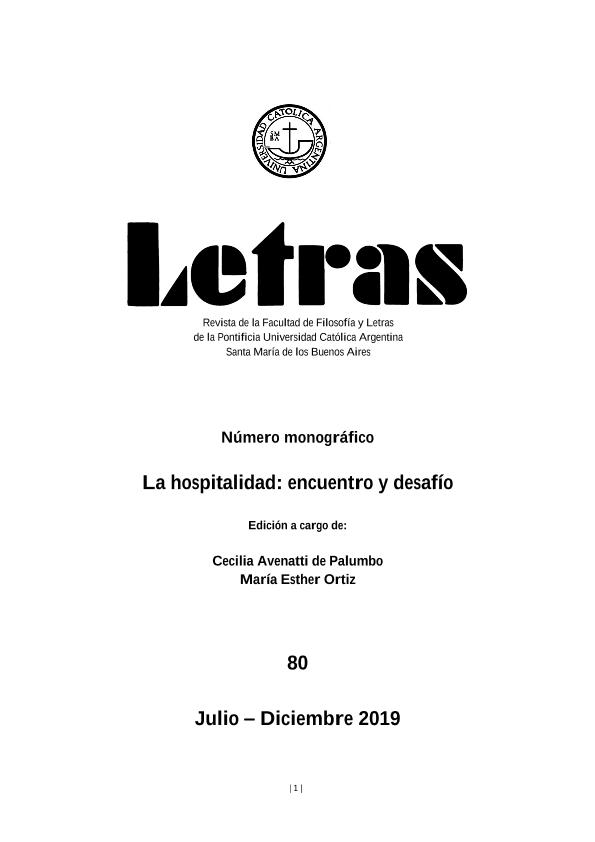Mostrar el registro sencillo del ítem
dc.contributor.author
Puppo, María Lucía

dc.date.available
2022-02-07T19:29:29Z
dc.date.issued
2019-07
dc.identifier.citation
Puppo, María Lucía; "Está viva la casa y habla": hospitalidad y poesía de mujeres; Pontificia Universidad Católica Argentina "Santa María de los Buenos Aires". Facultad de Filosofía y Letras; Letras; 2; 80; 7-2019; 64-71
dc.identifier.issn
0326-3363
dc.identifier.uri
http://hdl.handle.net/11336/151495
dc.description.abstract
La casa fue desde siempre, en innumerables culturas, el ámbito destinado a las mujeres. Si hasta el siglo diecinueve la casa familiar era percibida en la literatura como gineceo o reducto privado, cuna de la feminidad laboriosa, obediente y recatada, tras varias olas del feminismo la casa parece haber dejado de ser una cárcel para recuperar su estatus primigenio de ómphalos sagrado y centro del mundo, lugar propio e íntimo que a la vez protege y comunica con el exterior, habitado por múltiples presencias, voces y afectos. ¿Qué memoria guarda una casa? ¿Cómo habla Dios en ella? ¿Qué vínculos construyen los que habitan entre sus paredes? ¿Qué dejan y qué reciben quienes golpean a su puerta? ¿Cómo crece, cómo se expande, cómo se vacía o se transforma una casa? Siguiendo las pistas de estas preguntas, que revelan diversos rostros metafóricos de una hospitalidad sencilla y cotidiana, propondremos una lectura contrastada de los textos de tres poetas latinoamericanas: Dulce María Loynaz (La Habana, 1902-1997), Adélia Prado (Divinópolis, 1935) y Tamara Kamenzsain (Buenos Aires, 1947).
dc.description.abstract
The house has always been, in countless cultures, the area for women. If until the nineteenth century the family home was perceived in literature as a gynoecium or private domain where laborious, obedient and demure femininity was bred, after several waves of feminism the house seems to have ceased to be a prison in order to regain its original status as sacred omphalos and center of the world, an intimate place that at the same time protects and communicates with the outside, inhabited by multiple presences, voices and affects. What memory does a house keep? How does God speak in it? What links are established by those who inhabit it? There are those who knock at the door: what do they leave and what do they receive? How does a house grow, expand, become empty or get transformed? Following the clues of these questions, which reveal various metaphorical faces of a simple and everyday hospitality, we will propose a contrasted reading of the texts of three Latin American poets: Dulce María Loynaz (Havana, 1902-1997), Adélia Prado (Divinópolis, 1935) and Tamara Kamenzsain (Buenos Aires, 1947).
dc.format
application/pdf
dc.language.iso
spa
dc.publisher
Pontificia Universidad Católica Argentina "Santa María de los Buenos Aires". Facultad de Filosofía y Letras
dc.rights
info:eu-repo/semantics/openAccess
dc.rights.uri
https://creativecommons.org/licenses/by-nc-sa/2.5/ar/
dc.subject
CASA
dc.subject
HOSPITALIDAD
dc.subject
POESÍA LATINOAMERICANA
dc.subject
POESÍA DE MUJERES
dc.subject.classification
Estudios Generales de Literatura

dc.subject.classification
Lengua y Literatura

dc.subject.classification
HUMANIDADES

dc.title
"Está viva la casa y habla": hospitalidad y poesía de mujeres
dc.title
“The House is Alive and Speaking”: Hospitality and Women’s Poetry
dc.type
info:eu-repo/semantics/article
dc.type
info:ar-repo/semantics/artículo
dc.type
info:eu-repo/semantics/publishedVersion
dc.date.updated
2022-01-25T15:00:55Z
dc.journal.volume
2
dc.journal.number
80
dc.journal.pagination
64-71
dc.journal.pais
Argentina

dc.journal.ciudad
Buenos Aires
dc.description.fil
Fil: Puppo, María Lucía. Consejo Nacional de Investigaciones Científicas y Técnicas; Argentina. Pontificia Universidad Católica Argentina "Santa María de los Buenos Aires". Facultad de Filosofía y Letras. Departamento de Letras. Centro de Estudios de Literatura Comparada "María T. Maiorana"; Argentina
dc.journal.title
Letras
dc.relation.alternativeid
info:eu-repo/semantics/altIdentifier/url/https://erevistas.uca.edu.ar/index.php/LET/article/view/3104
Archivos asociados
